Sometimes I feel like I spend so much time reading photography tricks and tips online that I never see anything new anymore. So, I set out to make this useful collection of some weird and cool photography tricks that aren't your usual run-of-the-mill variety.
I hope you find some joy and learn a new tip or two. When you're done, comment below with what cool photography hacks you've learned!

1. No tripod? Use a lamp!
Want to take a group photo but don't have a place to set the camera? Just whip the lamp shade off a lamp and screw your camera onto the lampshade-holder.
The thread size of the bolt on a lamp shade is exactly the same size as the filter thread used on tripods, so your camera will easily attach.
Not only will your party and indoor pictures look better, but you'll look like MacGyver in front of the group. Not bad. This tip doesn't come in handy every day, but you'll like the coolest photography nerd on the planet when the situation arises.
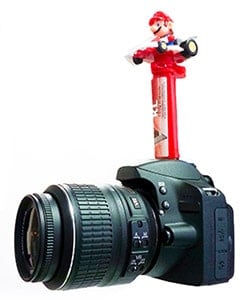
2. Hotshoe PEZ Dispenser for kids
Shooting photos of kids can be quite the feat. It seems like they are interested in looking at everything BUT the camera. I have two kids of my own, and I know that the only way to get them to smile and look at the camera is with a good bribe.
The perfect solution is to buy a simple PEZ dispenser on the hotshoe of your camera! The base of the PEZ dispenser is a tiny bit wider than a standard hotshoe, so you'll have to trim it just slightly with a kitchen knife before the shoot.
Then, when the kids are being good and looking at the PEZ dispenser, you can have them come up and grab a little candy periodically during the shoot. It's pure genius.
3. Day to night in a flash

Sometimes you're out shooting portraits on a bright sunny day and the light just looks too… natural. I often find this is the case when shooting a wedding or engagement when I'm shooting at a park or other outdoor location and I get bored with the same lighting in every shot.
One trick that I really enjoy is to turn up the power on my flash to the max. This will, obviously, make the subject extremely bright. If you change your camera settings to expose for the subject, it will make the background look extremely dark because the flash didn't hit it.
This makes it look like it's night time even if it's the middle of the day. Click here to read a full explanation of this technique.

4. Remove the lens for macro
This is the coolest camera trick I've seen in a long time. If you take off your lens and hold it in front of the camera, you get a macro lens! I was really skeptical about this, but I just tried it and it worked like a charm.
There are four things you need to know about using this trick: (1) Your camera won't take a picture with the lens off unless you're in manual mode. (2) The best focal length seems to be around 50mm, so either a 50mm prime or an 18-55mm kit lens would be perfect! (3) Obviously, you lose autofocus since your lens isn't attached to the camera. Focus is achieved by simply moving closer to or further away from the subject, and (4) The camera can't open up the aperture, so you'll do it with your hand. On the back of the lens (the side you mount on the camera), move the little plastic slider piece that controls the aperture. If you look in the lens while doing it, you'll see the hole open up.
If you want to take this a step further, you can buy a reverse lens mount for $5 or $10 which should sharpen up the images quite a bit since it will hold the lens more solidly. Also, be sure to use a tripod when doing this or any other macro photography. With such fine detail, even a tiny movement can destroy the sharpness.
5. Delete tourists from travel photos
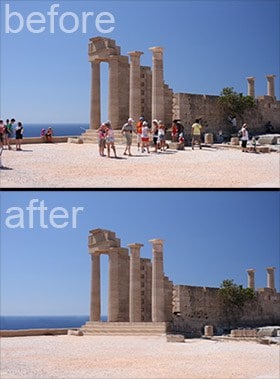
This is an awesome trick for travel photographers. Sometimes you're at an amazing location, but there are people in the way of your shot. If you want to take a picture of a landmark and people are in your shot, you will likely spend the rest of your adult life cloning people out of the shot unless you try this technique.
Step 1: Set your camera on a tripod.
Step 2: Take a picture about every 10 seconds until you have about 15 shots, depending on how fast people are walking around.
Step 3: Open all the images in Photoshop by going to File > Scripts > Statistics. Choose “median” and select the files you took.
Step 4: Bam! Photoshop finds what is different in the photos and simply removes it! Since the people moved around, it fills the area where someone was standing with part of another photo where no one was there.
UPDATE: The “statistics” script mentioned here is only available in Photoshop Extended or in the Creative Cloud version of Photoshop; however, as someone mentioned in the comments, you can get a somewhat similar effect in recent versions of Photoshop Elements by going to Enhance > Photomerge > Scene Cleaner.
This tip is mentioned in an outdated article on lifehacker.
 6. Shaped bokeh out of paper
6. Shaped bokeh out of paper
We all love to see beautiful bokeh in the background of our photos, but what you may not know is there is a really simple way that you can change the shape of the light bursts in your bokeh.
All you have to do is cut out a piece of black paper the size of the front element on your lens. Then, use a sharp kitchen knife or razor blade to cut a shape on in the middle of the paper. The shape should be slightly larger than a thumbnail or about the size of a U.S. nickel.
Keep in mind that you'll only see this effect work if you are shooting with a large aperture, so a 50mm f/1.8 would be a great choice for this project. If you're shooting at f/5.6 on a kit lens, you likely won't see the effect at all.
[callout type=”center” title=”Photography Portfolio Reviews – $55″ message=”Have the expert editors at Improve Photography review your photography portfolio in-depth and send you an audio feedback file for just $55″ button_text=”Check it out” href=”https://improvephotography.com/online-portfolio-reviews”]
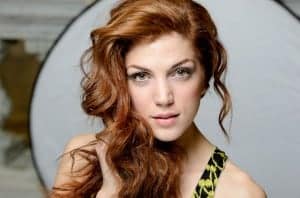
7. Reflector as studio backdrop
Sometimes when I'm shooting outdoor portraits, I see a pose or an expression for the model that makes me wish we were in the studio so I could photograph them on a white background. Sometimes a white background is the best way to focus all attention in the photo on the model, and it gives the photo a bright and clean look. When I'm in this situation, I often grab a simple $25 reflector and use it as a studio backdrop on the spot!
The trick for making this technique work is to use positive exposure compensation. The camera will try and dim down the white background to a dull gray because it thinks the white is overexposed. About 1 stop of exposure compensation will make the reflector background look bright white. If you're still learning to shoot in manual mode or how exposure compensation works, you might take a look at my beginner photography class that I offer online.
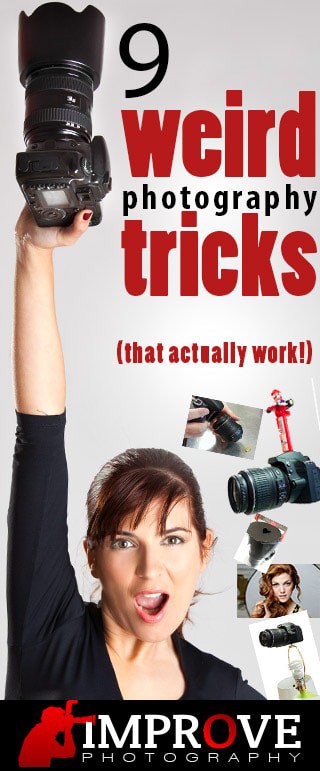
8. Camera strap GND filter
This is my all-time favorite landscape photography tip because I use it all the time and most people have never heard it before. When shooting landscapes, the sky is often much brighter than the rest of the landscape so you need something to darken down just that top part of the photo. A graduated neutral density filter does exactly that.
A GND filter is a piece of glass that is darkened at the top and which gradually tapers off to clear. The photographer simply holds this filter in front of the lens to cover the sky and it darkens the sky without affecting the landscape underneath.
Call me forgetful, but I often forget to bring my GND filter with me when I'm shooting landscapes, and it can ruin the shoot if I can't darken down the sky to balance the exposure. One trick I've learned is that you can simply use anything dark (a black piece of paper, a camera strap, etc) to hold in front of the lens for part of the exposure and the same thing is accomplished.
For example, while filming video tutorials for my intermediate online photography class, I was shooting waterfalls in Oregon and needed to darken the sky without darkening the rest of the frame. Since it was early morning, I was using a 2 second exposure. All I had to do was hold my camera strap over the top half of the glass on my lens for 1 second, and then remove it.
This makes it so the top half of the picture only sees light for half of the time, so it is much darker. And no, you won't see the camera strap in the photo since it's black.
9. Insulation reflector board
I debated whether or not this counts as a “camera trick” or if it's really just a super-awesome reflector that costs basically nothing. Call it what you will, but it works so well that I have to share this tip.
Circular reflectors are excellent for improving the lighting in your outdoor portraits. By holding them to reflect the sun's light, you can fill in shadows and put beautiful highlights on the face of the person you're shooting. However, most circular reflectors only work for a head-and-shoulders shot and only for one person. You can purchase a large full-body reflector, but they usually cost around $70.
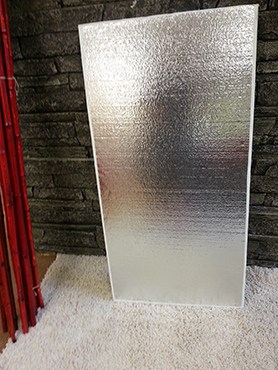
One trick I learned from a photographer who shoots celebrities is to simply purchase insulation board for $5 and then cover the back and edges with white duct tape. You'll find insulation board with reflective silver backing at any home improvement store. It comes in several sizes. I chose one that is 4 feet (1.2 meters) in height.
This simple solution gives you a very large reflector that is lightweight, and you can use one side to reflect silver and the other side to reflect white. Awesome!
Oh, and I also use this as a way to put a little wind in the hair of my models when I'm shooting someone with long hair. Just have an assistant fan up and down with the reflector board and it gives just the right amount of wind to give the hair some bounce without blowing the models away.
10. Get the Popular Trick Photography eBook
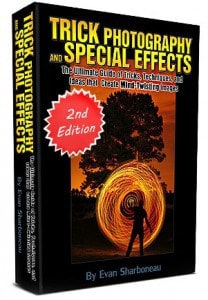
I like that the book has so many projects of exactly how each photo is taken so you can use the ideas in your own photography.
You can find out more about the book here.

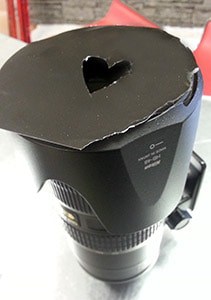
Whether you’ve got tons of cash to pour into a high-end camera or you’re shooting with a thirty-year-old film camera, the principle remains the same: a camera is a *tool*. Experience, imagination, eye, timing, a little luck and a lot of hard work make a photographer.
Just because you can afford to pour thousands into a camera and equipment, that doesn’t automatically make you a photog; by the same token, just because you shoot with something simple and/or old, that doesn’t mean you’re not.
Thanx for the tips, Jim– I’ll be certain to give them a whirl!
–J
You don’t need the best camera for the best photography you need a natural eye. I’ve got a good quality camera and am a rubbish photographer as I just don’t have that ability to spot the moment. My 11 year old does, and WOW the pictures she takes are outstanding and her camera was £30. The best camera in the world won’t make you an amazing photographer.
Hi there. I loved reading these tips! I have a kind of random question. It may be pointless in even asking, but thought I’d give it a shot anyways ( pun not intended!). So, I am really into nail art and I think I’m pretty good at it. I’ve been approached by quite a few polish makers who would like me to use their products and photograph them. This is a very exciting prospect for me, except…I have virtually no way to take decent photos. I own only an iPad mini, which has no flash. I don’t even own a cheapie camera. So, as you can imagine, it’s extremely difficult to get a decent photo. Trying to photograph my left hand while snapping with my right is not easy. I know at there are tons of things that I can buy, problem is, I am literally flat out broke. I’m a newly single Mom and funds are extremely tight. I’d love to find a way to make this work out b/c it is my therapy. Sounds cheesy, but It soothes my soul,I’ve always wanted to get into photography but that’s not really possible right now. Anyways, aside from my rambling….I was wondering g if you had any tips at all. As I stated, money is very limited ( I cannot really buy much of anything) so any cheap DIY TIPS WOULD BE GREATLY APPRECIATED. I have a hard time with lighting, keeping the iPad steady,etc. I really need to find a way to make this work. It’s one of the few things that bring me happiness. Any tips? Thanks in advance.
Just love the tips!!!!! Ricardo [link removed as violation of comment policy]
@Lindsey
As the camera on your ipad is in the corner try placing the centre of the ipad on a tumbler or glass as a makeshift tripod (experiment until you find the best height).
Next try (something like tip 7) use a sheet of white paper on the table under your nails to focus attention on your nails.
The focus recognition on the ipad should pick out your nails as the focal and exposure point (yellow square). If not, just tap the screen where your nail is to tell the ipad to clue it’s attention on your nail.
Try to find a room with natural light and avoid casting shadows from yourself, the ipad or other objects around.
Let us know how it goes.
Thanks for the tips Now I know what to when things to don’t look right.
Love, love, love #9! Great article!
Thanks! Great ideas
I lie the photoes and tips are very great especially i liked the camera strap GND filter.Thanks for sharing.
Great tips-thanks!
Has anyone tried #5 using PS Elements 11? Would love to know if it works…. Loved tip #9. What a great idea!
#5 is really cool, I’ll go outside to try if it works. Thank you.
fascinating !!!
Amazing. I am looking forward to testing out #5.
Learning new trick photography ideas is a best practice to improve your photography skills! Trick photography is one of the friendliest subgenres of photography, because it gives “shooters” the freedom that they wouldn’t have if they practiced purely conventional photography.
Love the insulation board reflector!
These are great. Thank you for sharing
Just stumbled across these; a fantastic guide! Another trick we use outdoors is to take a simple black golf umbrella to reduce glare and uneven highlights while shooting on hot, sunny days of under trees where shadows become distracting.
Great weird tips! I love all them and want to try them out. Thanks for sharing!
Hello, thank you for the wonderful information. I would like to ask you a question if possible. I just bought Olympus Stylus 1 but in a photography class I attended recently the instructor told me olympus XZ-2 iHS is a a better choice. I bought the camera for a thailand trip and I am a beginner so I will use mostly aperature priority and program mode. I don’t know if I should return the camera and exchange with Xz or just the keep the stylus 1! I will travel to thailand in 2 weeks and if you can help me I would really appreciate. Thank you so much.